Surgery recovery represents a critical period where the body works to repair itself while patients navigate the delicate balance between adequate rest and appropriate activity. The choices made during this vulnerable time can dramatically impact healing speed, complication rates, and long-term outcomes. Understanding the essential dos and don’ts of surgical recovery empowers patients to take active roles in their healing journey.
The human body possesses remarkable healing capabilities, but surgical recovery requires specific conditions to optimize these natural processes. Proper recovery involves more than simply waiting for wounds to close; it encompasses nutrition, movement, wound care, medication management, and recognizing warning signs that require immediate attention.
Essential recovery dos for optimal healing
Do follow medication schedules precisely
Pain management and infection prevention medications work best when taken consistently as prescribed. Setting phone alarms or using pill organizers helps maintain proper timing, especially when pain medications can cause confusion or drowsiness. Skipping doses or taking medications irregularly can lead to breakthrough pain that becomes harder to control and may increase infection risk.
Anti-inflammatory medications prescribed after surgery serve specific purposes beyond pain relief, often reducing swelling that could impede healing. Blood thinners, when prescribed, prevent dangerous clot formation but require exact timing to maintain therapeutic levels. Even seemingly simple medications like stool softeners play important roles in preventing complications from pain medication side effects.
Do prioritize proper nutrition for tissue repair
Surgical healing demands increased protein intake to build new tissue and repair damaged areas. The body requires additional calories during recovery to fuel the healing process, making this an inappropriate time for restrictive dieting. Adequate hydration supports circulation, helps flush toxins, and maintains the fluid balance necessary for cellular repair.
Vitamin C plays crucial roles in collagen formation, which provides structural support for healing wounds. Zinc contributes to protein synthesis and immune function, both essential for recovery. Iron supports oxygen transport to healing tissues, while B vitamins assist in energy metabolism needed for repair processes.
Fresh fruits and vegetables provide antioxidants that combat inflammation and support immune function. Lean proteins from various sources ensure amino acid availability for tissue building. Whole grains provide sustained energy without blood sugar spikes that can interfere with healing.
Do maintain appropriate activity levels
Early mobility, when approved, prevents dangerous blood clots and maintains muscle strength. Even simple movements like ankle pumps, deep breathing exercises, and position changes can significantly impact recovery outcomes. Progressive activity increases help rebuild strength without overwhelming healing tissues.
Walking represents one of the safest and most beneficial activities during early recovery. It promotes circulation, prevents pneumonia, maintains bowel function, and supports mental health. Starting with short distances and gradually increasing duration allows the body to adapt without strain.
Do practice meticulous wound care
Proper hand hygiene before touching surgical sites prevents infection introduction. Clean hands with soap and water or alcohol-based sanitizer become essential tools in recovery success. Even family members helping with care must maintain strict hygiene standards.
Keeping surgical sites clean and dry creates optimal healing conditions while preventing bacterial growth. Following specific cleaning instructions for different wound types ensures appropriate care without damage to healing tissues. Some wounds require daily cleaning, while others heal better with minimal disturbance.
Monitoring surgical sites daily allows early detection of problems before they become serious complications. Taking photos can help track healing progress and provide valuable information for healthcare providers if concerns arise.
Critical recovery don’ts that prevent proper healing
Don’t ignore warning signs of complications
Fever above normal ranges often indicates infection or other serious complications requiring immediate attention. Increasing pain after initial improvement suggests possible problems like infection, bleeding, or wound separation. Red streaking around surgical sites signals spreading infection that can become life-threatening without prompt treatment.
Excessive swelling, particularly when accompanied by warmth and redness, may indicate infection or blood clots. Unusual drainage from surgical sites, especially if foul-smelling or containing pus, requires urgent evaluation. Breathing difficulties, chest pain, or leg swelling could signal dangerous blood clots.
Don’t rush back to normal activities
Lifting restrictions exist to prevent wound separation, hernia formation, and internal bleeding. Even seemingly light objects can create internal pressures that overwhelm healing tissues. Gradual return to lifting allows tissues to strengthen progressively.
Driving too soon after surgery poses dangers from delayed reflexes, medication effects, and physical limitations. The ability to perform emergency maneuvers safely requires full range of motion and quick reaction times that may be compromised during recovery.
Returning to work prematurely can slow healing and increase complication risks. Mental fog from medications, physical limitations, and fatigue can affect job performance and safety. Each surgery type requires specific recovery timelines that shouldn’t be shortened without medical approval.
Don’t neglect hygiene and wound care
Soaking surgical sites in baths, pools, or hot tubs introduces bacteria and keeps wounds excessively moist, preventing proper healing. Showering with proper wound protection maintains cleanliness without creating infection risks. Waterproof coverings or avoiding direct water contact protect healing tissues.
Picking at scabs, removing stitches early, or manipulating surgical sites disrupts the healing process and increases scarring. The urge to scratch itchy healing wounds is natural but must be resisted to prevent damage and infection.
Don’t consume alcohol or smoke during recovery
Alcohol interferes with medication effectiveness and can cause dangerous interactions with pain medications and antibiotics. It also impairs immune function when the body needs maximum infection-fighting capability. Alcohol disrupts sleep patterns essential for healing and can increase bleeding risks.
Smoking severely restricts oxygen delivery to healing tissues, dramatically slowing recovery and increasing complication rates. Nicotine constricts blood vessels, reducing the nutrient and oxygen supply necessary for tissue repair. Even secondhand smoke exposure can negatively impact healing.
Managing pain and discomfort effectively
Pain management requires balance between comfort and alertness. Taking pain medication proactively, before pain becomes severe, provides better control with lower doses. However, over-reliance on medications can lead to dependency and side effects that complicate recovery.
Ice application reduces swelling and provides natural pain relief for many surgery types. Elevation of surgical sites, when appropriate, helps reduce swelling and discomfort. Heat therapy may benefit some conditions but should only be used when specifically recommended.
Distraction techniques like gentle music, light reading, or visitor conversations can help manage pain perception. Relaxation techniques, including deep breathing and meditation, provide natural pain relief while supporting overall recovery.
Sleep and rest optimization
Quality sleep accelerates healing by allowing the body to focus energy on repair processes. Creating comfortable sleeping positions that protect surgical sites while promoting rest requires creativity and patience. Extra pillows, wedges, or specialized positioning devices can help maintain proper alignment.
Establishing regular sleep schedules supports the body’s natural healing rhythms. Avoiding screens before bedtime and creating dark, quiet environments promote deeper, more restorative sleep. Managing pain medication timing to provide nighttime comfort without excessive sedation improves sleep quality.
Emotional and mental health considerations
Surgery recovery often includes emotional challenges from pain, limitations, and medication effects. Mood changes, anxiety, and depression represent normal responses to surgical stress but shouldn’t be ignored if they become overwhelming. Maintaining social connections and communication with loved ones supports mental health during recovery.
Setting realistic expectations prevents disappointment and frustration when recovery doesn’t progress as quickly as hoped. Understanding that healing occurs in stages helps patients recognize progress even during challenging periods.
Recovery from surgery demands patience, attention to detail, and commitment to following proven guidelines. The investment in proper recovery practices pays dividends in faster healing, fewer complications, and better long-term outcomes. Each decision during recovery either supports or hinders the body’s natural healing processes, making knowledge of these dos and don’ts essential for surgical success.













